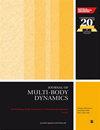A vibration model of a rotor system with the sinusoidal waviness by using the non-Hertzian solution
IF 1.9
4区 工程技术
Q3 ENGINEERING, MECHANICAL
Proceedings of the Institution of Mechanical Engineers Part K-Journal of Multi-Body Dynamics
Pub Date : 2021-12-23
DOI:10.1177/14644193211065916
引用次数: 2
Abstract
The nonlinear contact forces and deformations between the balls and raceways can cause very complex vibration behaviours of rotor systems with the waviness in the support bearings. However, almost all previous works that used sinusoidal waviness took the Hertzian solution as the calculation method, which is not an accurate method based on Johnson’s formulation since the changes in the curvature at the sinusoidal contact surfaces. To overcome this issue, a new dynamic model of a rigid rotor system with the waviness in the support bearings is proposed. To provide a more accurate nonlinear contact force formulation for the sinusoidal waviness profile, the model used the Johnson’s extended Hertzian contact model to replace Hertzian contact model. This model can consider the time-varying curvature between the mating sinusoidal surfaces. The lubricating condition in the support bearing is also considered. A comparative study on the effects of Hertzian contact model, simplified Hertzian contact model, and Johnson's extended Hertzian contact model on the nonlinear vibrations of the rotor system is developed. The effects of the waviness amplitude and orders on the vibrations of the rotor system are discussed. The comparative simulations show that the proposed model can provide a more reasonable approach for predicting the vibrations of the rigid rotor system. Moreover, the simulations give that the nonlinear contact forces in the support bearings can greatly affect the system vibrations.用非赫兹解建立了具有正弦波的转子系统的振动模型
滚珠和滚道之间的非线性接触力和变形会导致转子系统具有非常复杂的振动行为。然而,以往使用正弦波度的工作几乎都是采用赫兹解作为计算方法,由于正弦波接触表面曲率的变化,基于Johnson公式的赫兹解并不是一种精确的方法。为了克服这一问题,提出了一种考虑支承轴承波动的刚性转子系统动力学模型。为了提供更精确的正弦波形轮廓非线性接触力公式,该模型采用Johnson扩展赫兹接触模型代替赫兹接触模型。该模型考虑了配合正弦曲面之间的时变曲率。还考虑了支承轴承的润滑状况。对比研究了赫兹接触模型、简化赫兹接触模型和Johnson扩展赫兹接触模型对转子系统非线性振动的影响。讨论了波纹幅值和阶数对转子系统振动的影响。对比仿真结果表明,该模型可以为刚性转子系统的振动预测提供一种更为合理的方法。仿真结果表明,支承轴承中的非线性接触力对系统振动有很大影响。
本文章由计算机程序翻译,如有差异,请以英文原文为准。
求助全文
约1分钟内获得全文
求助全文
来源期刊

CiteScore
4.10
自引率
11.10%
发文量
38
审稿时长
>12 weeks
期刊介绍:
The Journal of Multi-body Dynamics is a multi-disciplinary forum covering all aspects of mechanical design and dynamic analysis of multi-body systems. It is essential reading for academic and industrial research and development departments active in the mechanical design, monitoring and dynamic analysis of multi-body systems.
 求助内容:
求助内容: 应助结果提醒方式:
应助结果提醒方式:


